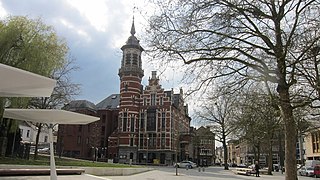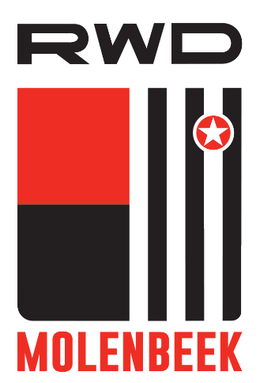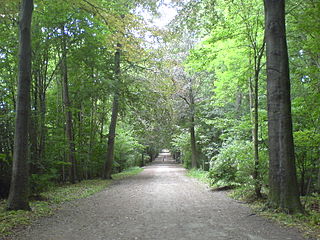
Jette is one of the 19 municipalities of the Brussels-Capital Region, Belgium. Located in the north-western part of the region, it is bordered by the City of Brussels, Ganshoren, Koekelberg, and Molenbeek-Saint-Jean, as well as the Flemish municipalities of Asse and Wemmel. In common with all of Brussels' municipalities, it is legally bilingual (French–Dutch).

Dilbeek is a municipality in the province of Flemish Brabant, in the Flemish region of Belgium. The municipality comprises the villages of Dilbeek proper, Groot-Bijgaarden, Itterbeek, Schepdaal, Sint-Martens-Bodegem, and Sint-Ulriks-Kapelle. Dilbeek is located just outside the Brussels-Capital Region in the Pajottenland, hence the local name Poort van het Pajottenland.

Grimbergen is a municipality in the province of Flemish Brabant, in the Flemish region of Belgium, 10 km (6.2 mi) north of the capital Brussels. The municipality comprises the towns of Beigem, Grimbergen, Humbeek, and Strombeek-Bever. In 2017, Grimbergen had a total population of 37,030. The total area is 38.61 km2 (14.91 sq mi), which gives a population density of 959/km2 (2,480/sq mi).

Lucas Achtschellinck was a Flemish landscape painter. He is counted among the landscape painters active in Brussels referred to as the School of Painters of the Sonian Forest who all shared an interest in depicting scenes set in the Sonian Forest, which is located near Brussels.

The Bois de la Cambre or Ter Kamerenbos (Dutch) is an urban public park in Brussels, Belgium. It lies in the south of the Brussels-Capital Region, in the City of Brussels, and covers an area of 1.23 km2 (0.47 sq mi), forming a natural offshoot of the Sonian Forest, which penetrates deep into the city in the south-east of Brussels. It is linked to the rest of the municipality by the Avenue Louise/Louizalaan, which was built in 1861, at the same time the park was laid out.

The Sonian Forest or Sonian Wood is a 4,421-hectare (10,920-acre) forest at the south-eastern edge of Brussels, Belgium. It is connected to the Bois de la Cambre/Ter Kamerenbos, an urban public park which enters the city up to 4 kilometres (2.5 mi) from the city centre.

Uccle or Ukkel is one of the 19 municipalities of the Brussels-Capital Region, Belgium. Located in the southern part of the region, it is bordered by the City of Brussels, Forest, Ixelles, and Watermael-Boitsfort, as well as the Flemish municipalities of Drogenbos, Linkebeek and Sint-Genesius-Rode. In common with all of Brussels' municipalities, it is legally bilingual (French–Dutch).

Gaasbeek Castle is a castle located in Lennik, Flemish Brabant, Belgium. Nowadays, it serves as a national museum. It is surrounded by a park.

Laurent-Benoît Dewez was a Belgian architect of Walloon origin. He is considered the most influential architect in the Austrian Netherlands from the second half of the 18th century. His architectural projects are of international stature and introduced a neoclassical style, with Italian and English influences, to the region. He designed a large number of châteaux, abbeys and churches in Belgium, many of which were damaged after the French Revolution.

Groot-Bijgaarden Castle is a 12th-century castle in Groot-Bijgaarden in the municipality of Dilbeek, Flemish Brabant, Belgium. The castle was built for Almaric de Bigard, the first lord of Bigard. Groot-Bijgaarden Castle is situated at an elevation of 47 metres (154 ft).

Auderghem or Oudergem is one of the 19 municipalities of the Brussels-Capital Region, Belgium. Located in the south-eastern part of the region, along the Woluwe valley and at the entrance to the Sonian Forest, it is bordered by Etterbeek, Ixelles, Watermael-Boitsfort, and Woluwe-Saint-Pierre, as well as the Flemish municipalities of Tervuren and Overijse. In common with all of Brussels' municipalities, it is legally bilingual (French–Dutch).

Lodewijk de Vadder was a Flemish Baroque landscape painter, draughtsman, engraver and tapestry designer. His landscapes represent a move away from the Mannerist tradition of landscapes painting in Flemish art towards a more naturalistic approach exemplified by looser brushwork and an emphasis on atmospheric effects. He was the first Flemish landscape painter who painted dune landscapes as the primary feature of his landscapes. While his loose brush handling shows the influence of Rubens and Adriaen Brouwer, his restrained palette shows his awareness of developments in the Dutch Republic.
Zellik is an urbanised town with over 8,000 inhabitants in the municipality of Asse, in the province of Flemish Brabant, Belgium. As a suburb on the northwest edge of Brussels, it is separated from the rest of the agglomeration by the R0 ring road around the city. It is close to the municipalities of Jette, Ganshoren and Sint-Agatha-Berchem, which lie to the east.

The Brussels Ring, numbered R0, is a ring road surrounding the Brussels-Capital Region, as well as other smaller towns south of Brussels. It is about 75 kilometres (47 mi) long, with two or three lanes in each direction. While most of it is classified as a motorway (highway), part of it is merely an express route. It crosses the three regions of Belgium: its main part is situated in Flanders, whereas Wallonia comprises 18.2 kilometres (11.3 mi) of the total stretch and 5.5 kilometres (3.4 mi) is on Brussels territory.

Dieleghem Abbey or Dielegem Abbey is a former abbey located in the Brussels municipality of Jette, Belgium. It was abolished in 1796.

The following is a timeline of the history of Brussels, Belgium.

Racing White Daring Molenbeek, also known as RWD Molenbeek and often referred to as RWDM, is a Belgian professional football club based in Molenbeek-Saint-Jean, Brussels. As of the 2024–25 season, the club plays the second after relegation from the 2023–24 Belgian Pro League, the club's first season back in the top flight. The club is seen in Belgium as a continuation of previous clubs with the same name that went out of business.
The N23 is a short national highway in the Brussels Capital Region, Belgium. It is one of the busiest roads within the capital with daily gridlock during the rush hours.

Dieleghem Wood or Dielegem Wood is a public forest in the municipality of Jette in Brussels, Belgium. It covers an area of 9 hectares and was acquired by the municipality in 1952. Along with the Poelbos and Laerbeek Wood, Dieleghem Wood is an integral part of the regional King Baudouin Park.




















